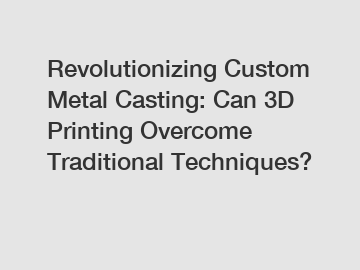Revolutionizing Custom Metal Casting: Can 3D Printing Overcome Traditional Techniques?
Revolutionizing Custom Metal Casting: Can 3D Printing Overcome Traditional Techniques?
Metal casting has been an essential process for centuries, allowing manufacturers to create complex metal parts for various industries. However, the traditional methods of custom metal casting are often labor-intensive, time-consuming, and limited in design flexibility. In recent years, 3D printing has emerged as a promising technology that could revolutionize the metal casting industry. With its ability to create complex geometries and reduce manufacturing time, 3D printing has the potential to overcome the limitations of traditional techniques. This article explores the possibilities and challenges of using 3D printing in custom metal casting.
The Advantages of 3D Printing in Custom Metal Casting.

1. Design Flexibility: One of the most significant advantages of 3D printing in custom metal casting is the ability to create highly complex and intricate designs. Traditional metal casting methods involve the use of molds and patterns, which limit the intricacy of the final product. With 3D printing, designers can easily create complex geometries that were previously impossible to achieve. This opens up new possibilities for product innovation and customization.
2. Time Efficiency: Another advantage of 3D printing in metal casting is its ability to significantly reduce manufacturing time. Traditional metal casting techniques involve multiple steps, including mold creation, pattern making, and casting. Each step adds to the overall lead time. In contrast, 3D printing allows for the direct creation of metal parts without the need for molds or patterns. This streamlined process eliminates time-consuming steps, resulting in faster production cycles and quicker market entry.
3. Waste Reduction: Traditional metal casting often results in significant material waste. As molds and patterns are used in each casting, changes in design or product variations require the creation of new molds, leading to material waste. In contrast, 3D printing allows for the production of metal parts on-demand, reducing the need for excess inventory and eliminating material waste. This sustainability aspect is not only environmentally friendly but also economically beneficial.
Challenges in Implementing 3D Printing in Custom Metal Casting.
1. Material Limitations: While 3D printing in metal casting offers design freedom, it is crucial to consider the limitations of available materials. Some of the metals used in traditional casting, such as steel and iron, may be challenging to print using current 3D printing technologies. However, advancements in metal 3D printing techniques are rapidly expanding the range of printable metals, mitigating this challenge.
2. Cost Factors: As with any emerging technology, the cost of 3D printing in custom metal casting can be a substantial challenge. While the upfront costs of acquiring 3D printers and materials are significant, the long-term benefits of reduced lead times and customization potential can outweigh the initial investment. Additionally, as the technology matures and adoption increases, economies of scale may lead to cost reductions.
Conclusion.
The potential benefits of 3D printing in revolutionizing custom metal casting are undeniable. The technology offers design flexibility, time efficiency, and waste reduction that could transform the manufacturing landscape. As 3D printing continues to advance and overcome existing limitations, it is poised to become a game-changer in the metal casting industry.
Manufacturers seeking to stay ahead of the curve should explore the possibilities of integrating 3D printing into their custom metal casting processes. To learn more about the advantages and implementation of 3D printing in metal casting, please contact us.
Contact Us.
The company is the world’s best Stainless Steel Pipe Fitting Wholesale, Stainless Steel Valve Handle Manufacturer, Camlock Handle Ring supplier. We are your one-stop shop for all needs. Our staff are highly-specialized and will help you find the product you need.


